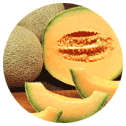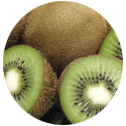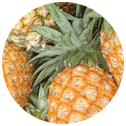 Full List of Fruits
Full List of Fruits  Mayapple
MayappleMayapple Fruit
![]() Introduction of Mayapple Fruit
Introduction of Mayapple Fruit
Scientific name - Podophyllum peltatum
Podophyllum, has its line in the family Berberidaceae, being an herbaceous perennial plant they are described as a genus by Linnaeus in 1753. During the past, quite a few species were included in the genre; some have been transferred to other genus. A distinguishing feature about this woodland plant is that it typically grows in colonies derived from a single root. In general, the fruit grows in colonies in leaf-losing forests, which means it takes up shade to grow well. With palmately lobed umbrella-like leaves, the fruits are produced early summer and ripen during the late summer. The stem of the tree grows to 30-40 cm tall with 3-9 shallowly to deeply cut lobes. With lots of seeds, the taste of the fruit is exotic and is green to yellow in color. Mayapple is one remaining species that is prevalent from corner to corner of most of the parts of eastern United States and Southeastern Canada. They are known by several common names such as devilís apple, hog-apple, Indian apple, American mandrake, American May apple, Racoonberry, and wild lemon.
Used widely by Native Americans, the edible fruit has lots of medicinal properties and when the fruit is fully ripe, it is eaten raw; however they can also be cooked or made into jams, jellies, marmalades, and pies. Giving away an aromatic flavor, it tastes peculiar and has a pleasant flavor.
![]() Health benefits of Mayapple Fruit
Health benefits of Mayapple Fruit
It has been used as an emetic, cathartic and antihelmintic agent by American Indians. They were also used topically for treating warts; etoposide and teniposide two of its derivatives are also used in treating malignant neoplasms. Spaced out from the ripe fruit, the whole plant is considered highly poisonous in large doses. The rhizome has been used for a range of medicinal purposes and the boiled poisonous root water was consumed for stomach aches. Caution- They are toxic! Having said all that, using it as a cathartic is considered unsafe. With some Cholagogue action, it is a drastic laxative in moderate doses. Using it while pregnant, nursing should be avoided, proper consultation should be part of the play.
The Mayapple fruit prefers areas with full or partial sun, but it can also tolerate shady spots. It does not do well in heavily shaded areas, however, and will not form fruit if there is not enough sunlight. The plant spreads by rhizomes and can form dense patches in the wild.
In order for the Mayapple fruit to grow and produce fruit, the plant must have adequate moisture and nutrients. The plant is not very tolerant of drought and will not produce fruit if it is too dry. It also requires adequate drainage, as wet soil can cause root rot. Additionally, the plant requires a moderate amount of soil fertility, as the plant is not very tolerant of low fertility soils.
The Mayapple fruit will also benefit from some pruning, as this can help to increase its productivity and help to keep the plant healthy. Pruning can also be used to control the spread of the plant and manage its growth.
The Mayapple fruit is a popular foraging food among North American foragers, and it is also used in many recipes. The fruit must be ripe before it is edible, and it is best eaten raw. It has a sweet, tart, and slightly bitter flavor and can be used in pies, jams, jellies, and other recipes.
The Mayapple plant has also been used medicinally for centuries. The plant's roots and leaves contain a substance called podophyllin, which is used to treat a variety of ailments, such as warts, skin conditions, and digestive disorders.
In conclusion, the Mayapple fruit is an interesting and flavorful fruit that grows in a variety of habitats in the United States. It can be found in moist and shady areas of deciduous woods, along stream banks, in clearings, and in old fields. The plant also requires adequate moisture and nutrients, as well as some pruning to help it produce fruit. The fruit is a popular foraging food and has also been used medicinally for centuries.
The mayapple plant can grow up to two feet tall and has a single umbrella-like leaf. It has a solitary white flower that appears in late spring and is followed by a single, yellow-green, apple-like fruit. The fruit is edible when ripe and is said to have a sweet, tart flavor.
Mayapple fruit is rich in antioxidants, vitamins, and minerals, making it a nutritious and beneficial addition to the diet. It is an excellent source of vitamin A, which is important for healthy skin and eyesight, and vitamin C, which helps to boost the immune system. It also contains several other vitamins and minerals, such as calcium, phosphorus, and iron.
Mayapple fruit has long been used as a natural remedy for many ailments. It is believed to be effective in treating skin conditions, such as eczema, psoriasis, and acne. It is also thought to be helpful in relieving digestive issues, such as constipation and irritable bowel syndrome.
In addition to its medicinal value, mayapple fruit can also be used in cooking. It can be made into a jam or jelly, or it can be added to salads, soups, and other dishes for a sweet and tart flavor. The fruit can also be dried and ground into a powder, which can be used to thicken sauces or as a flavoring for baked goods.
Mayapple fruit can be harvested from late June through August. It is best to pick the fruit when it is slightly soft and the color has changed from yellow-green to yellow-orange. The fruit should be eaten shortly after picking, as it will not last long once it is picked.
The cultivation of mayapple fruit is relatively easy as long as the plant is grown in the right conditions. It prefers moist, well-drained soils and partial shade. The soil should be enriched with organic matter, such as compost or well-rotted animal manure. The plant should be watered regularly and pruned to keep it healthy.
Mayapple fruit can be propagated by seed or through root division. The seeds should be planted in late spring or early summer, and the seedlings should be transplanted when they are 4 to 6 inches tall. The root divisions should be planted in early spring or late summer.
Mayapple fruit is a nutritious and beneficial addition to the diet and can be used in cooking or as an herbal remedy. It is relatively easy to cultivate and can be propagated by seed or through root division. With proper care and attention, mayapple fruit can be harvested for many years.
In order to form a gathering that shades out smaller plants, Mayapple spreads from underground rhizomes. It prefers shade and grows well in dappled shade. Moreover, makes an excellent groundcover for unused areas. Seeing that they spread out from underground rhizome, it requires plenty of space to spread out and likes light, loamy soil, and a shade spot, but not too dappled. Keeping it moist instead of wet will helps and until established they should be free of weeds. Once established, they inflate grows well. However, it will take some years to start producing fruit and the fruiting happens in May as the name goes by.
The fruit when ripe turns out to be yellow in color with a very soft flesh. They can be consumed raw or made into jelly or sliced thin and dried or dried whole for use in spells.
In view of the fact that, the roots are extremely dangerous, while handling with the foliage or roots, it is good to wear gloves and wash your hands thoroughly before touching your eyes or face.


















